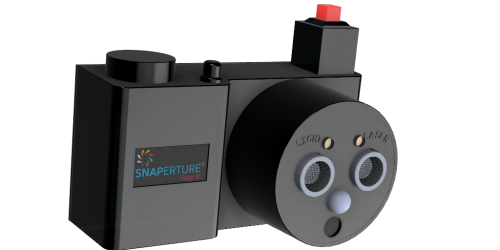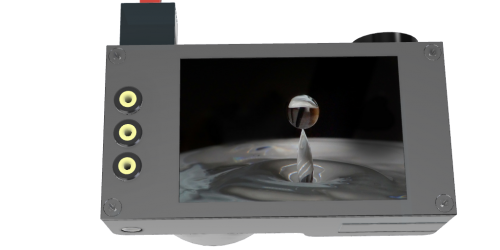
The cute face in Snaperture’s lens provides a convenient means of referencing the various sensors.
Light sensor (right eyebrow)
This has a programmable trigger level; it triggers on either an increasing or decreasing light level, with a choice of delay of between 0 seconds and 10 seconds, at one millisecond resolution.
Ultrasonic rangefinder (eyes)
This sensor is used to detect when a subject is a given distance from Snapertrure. It range is from 4 cm to 400 cm and a tolerance can be added to provide a range within which the target will be detected. Of course the range can be entered as zero, in order to detect targets at precise locations. As mentioned earlier, the laser sensor can be used in conjunction with this, giving a precise location in space.
Laser sensor (left eyebrow)
This sensor is used to add direction to the ultrasonic rangefinder, giving it the ability to combine direction with distance. In this way, Snaperture can detect when a subject occupies a predetermined position in 3D space – a truly invaluable capability.
PIR sensor (nose)
The passive infrared sensor detects movement of a warm body in Snaperture’s vicinity. The trigger event can be the detection of motion or the cessation of motion. Again, a programmed delay can be introduced for this event.
Sound sensor (mouth)
This microphone unit has a programmable trigger level that triggers on either an increasing or decreasing sound level, except for at the two extremes of the range. A delay delay of 0-10 seconds can be introduced between the sound event and the shutter operating, which can be specified to the millisecond.
ON/OFF switch
This is located on top of the “retro” flash cube and illuminates when Snaperture is ON, making it unlikely that the unit will be left on unintentionally.

Snaperture’s style is definitely retro, however one concession to the DSLR camera is the back panel “LCD screen”. This features the very first water drop image captured with Snaperture’s prototype device and is a reminder to the user of Snaperture’s capabilities.
The three jack sockets on the back panel are connections to the camera remote input, a flash unit and the water drop device. On the bottom surface can be seen the tripod mounting screw socket and the sliding door for access to the USB charging point.
Another invaluable component of Snaperture is its internal RTC (real time clock). This device allows for triggering the camera at a specific time, triggering at specific intervals and long exposures. All the information is programmed in advance, so the camera can be capturing images of the stars while you sleep.